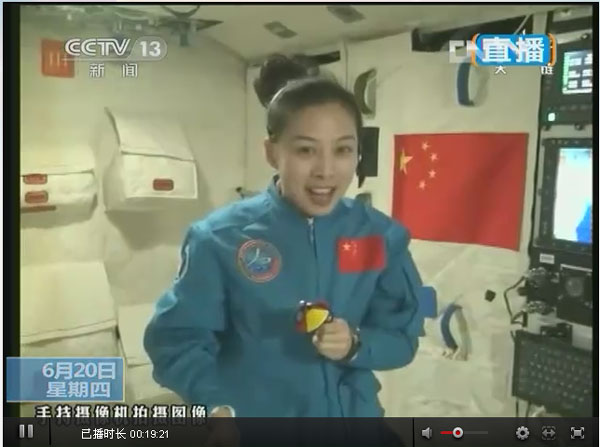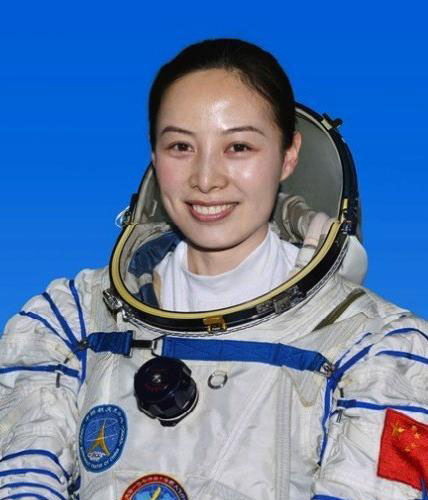Shenzhou X astronaut gives lecture
Updated: 2013-06-20 01:57
(chinadaily.com.cn)
|
|||||||||||
China's first "space class" ended at about 10:51 am Thursday. The astronauts will continue to stay in the Tiangong-1 orbiter to conduct space science and technology experiments.
In the interactive exchanges with students back on the Earth, Chinese astronauts aboard the Tiangong-1 orbiter also answered questions related to water use in spacecraft, space debris protection measures, ways to deal with gravity-free environment as well as space views.
10:48am
Wang Yaping makes a water film with a water bag and a metal ring. She explains to students that the surface tension of water magnifies in space due to zero gravity. Then she makes the second water film and pours water onto it. The water film turns into a water ball.
10:38am
Wang Yaping shows a small ball tied with a string to a holder fixed on a metal plate. She lets the ball go and the ball suspends. Then she pushes the ball gently and the ball moves in a circular motion.
Wang Yaping pushes a static gyro and a moving gyro respectively to change the way they move.
|
 |
A special lecture began Thursday morning, given by a teacher aboard a space module about 340 km above her students on Earth, the first such attempt by Chinese.
Female astronaut Wang Yaping, one of the three crew members of Shenzhou-10 spacecraft, greeted about 330 primary and middle school students at a Beijing high school, through a live video feed system.
"Hello, everyone. I am Wang Yaping. I will host the lecture today," she said, smiling towards the camera, on board of the space module Tiangong-1.
Wang and her crew members set off to the space aboard the Shenzhou-10 spacecraft on June 11 and the spacecraft docked with the Tiangong-1 on June 13.
The students on her class included children from migrant workers' families, of ethnic minorities and from Hong Kong, Macao and Taiwan. They gathered at the High School Affiliated to Renmin University in Beijing.
"I have been very excited since I learned that I could come to this class," said Luo Jiangyuan, in his first year of high school, who planned to study science in college.
"When I learned about those laws of physics and weightless condition at classes before, I needed to imagine what would happen. But, at today's class, I am able to see what really happens. It is thrilling," he said.
More than 60 million students and teachers at about 80,000 middle schools across the country are also watching the live broadcast on TV.
The first section of the class was all about weight.
Nie Haisheng, commander of the crew, made a bit show of crossing his legs into a meditation sitting posture in the air, which only a martial art master can do in the movies but is impossible for real people on Earth.
"Thanks to the weightless condition, we are all masters," Wang joked.
Ms Wang raised the first question to her students about how the astronauts measure their weight in the weightless orbiter, and showed them how normal scales, working under the influence of gravity, did not work inside the orbiter.
Then, she introduced the special scale on board of the orbiter, which was designed on basis of the Newton's second law of motion, or measuring the mass of an object through the net force and the acceleration.
Wang began the next demonstration. She tied a small ball with a string to a holder fixed on a metal plate.
"What will happen if I let the ball go?" she asked.
The ball did not swing as it usually does on Earth but suspended. When she pushed the ball gently, the ball moved in a circular motion, which stirred the classroom a bit.
Wang later pushed a static gyro and a moving gyro respectively to change the way they move.
When Wang made a water film with a water bag and a metal ring and turned another water film into a water ball, to explain how zero gravity magnified the surface tension of water, the children at the classroom cried out "Wow" with joyful surprise and applauded cheerfully.
"I like all these demonstrations, the gyro and water ball ones particularly. They are all impossible on Earth. How wonderful," said Qian Jianghao, a ten-year-old primary school boy at the class.
"I will be more interested in the space," said the boy who felt quite sorry for not being named to ask questions. "I have several good questions."
The students raised a number of questions concerning the difference of upside and downside in the space, the recycling of water in the orbiter, space debris, the impact of gravity-free environment on human body and the view through windows of Tiangong-1.
"Through the front windows, we can see the Earth and many other stars, but up till now, we haven't seen any UFOs," Wang said.
Stars are brighter but not twinkling and the sky is not blue but deep dark, she said.
"I tell you a wonderful phenomenon: we can see sunrises 16 times a day as we circle the Earth every 90 minutes," she said.
At the end of the class, the three astronauts extended best regards to the students.
"I wish all of you will study hard, learn more and contribute to the Chinese dream," said Nie.
"The outer space is deep and has numerous mysteries. The exploration is limitless and let us work together in this regard," says Zhang Xiaoguang, one of the crew.
"The dream of space never loses its gravity and the dream of science has no boundaries," said Wang.
Born in east China's Shandong Province, the hometown of China's most famous educationist Confucius (551-479 BC), the 33-year-old Wang is the second Chinese female astronaut after Liu Yang, who entered the record books in the Shenzhou-9 mission in June last year.
The world's first teacher in space was Christa McAuliffe, a 37-year-old middle school teacher from the United States, but the Space Shuttle Challenger she was aboard disintegrated after 73 seconds in flight on January 28, 1986. McAuliffe and her other six crewmates were killed.
Barbara Morgan, McAuliffe's backup in that mission who became an astronaut later, completed the teaching lesson in space in 2007, when she was sent to the International Space Station with Space Shuttle Endeavor. Via a video feed, she showed students how to exercise and drink water in space.
The lesson is aimed at making space more popular, as well as inspiring enthusiasm for the universe and science, according to Zhou Jianping, designer-in-chief of China's manned space program, who added that the lesson will also accumulate experience for similar larger activities.
"The spirit of science of the youth is an important drive for the progress of mankind," said Zhou. "Space activities can help them build up the spirit of seeking science and facing challenges."
|
 |
Special coverage:
China launches Shenzhou-X spacecraft